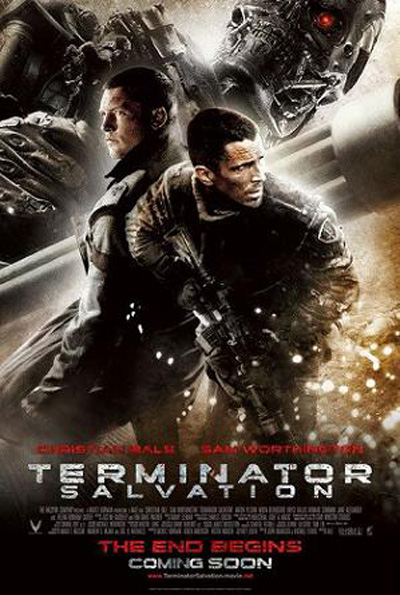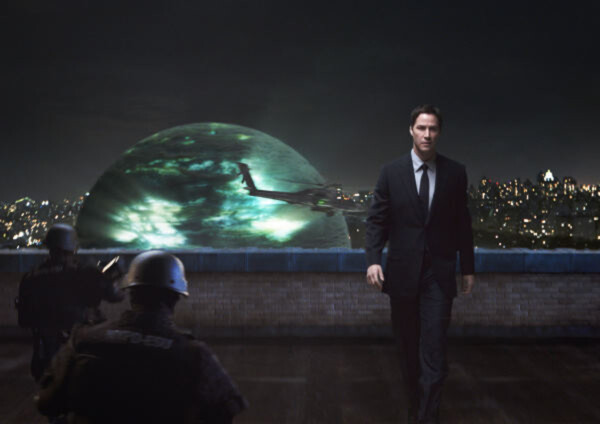Mladen and Del review ‘Terminator Salvation’

Image courtesy of Warner Brothers.
—
“Terminator Salvation” Starring Christian Bale, Sam Worthington, Anton Yelchin, Moon Bloodgood. Directed by McG. 114 minutes. Rated PG-13.
Mladen’s take
Take a little “Total Recall,” mix it with “Transformers,” sprinkle a tablespoon of “Mad Max,” bake at 350 degrees computer-generated special effects, and, voila, the result is “Terminator Salvation.”
“Salvation” is unable to compete with any of its three predecessors but it ain’t a bad film. One weakness is its PG-13 rating. There are plenty of explosions, but no close ups of bullets or shrapnel shredding bodies, or robo-hands tearing off heads.
The principal difference between “Salvation” and the other Terminator movies is that John Connor, humanity’s salvation, is now an adult and Kyle Reese, Connor’s father, is a child. Nevermind, it’s not worth explaining.
In the first three movies, the objective is to keep Connor alive. In the fourth, it’s making sure Reese avoids ingesting 40 7.67-mm rounds per second from a minigun.
Christian Bale, as Connor, plays what has now become a potentially career-ending typecast for him, a brooding, mopey hero.
The most interesting character in “Salvation” is the machine army’s first T-800 cybrid assassinator, which is unaware of its origin or allegiance. Sam Worthington portrays the cybrid, known as Marcus Wright.
Once you overlook the murkily explained way Wright becomes the next-generation terminator, his portrayal of a sentient machine enduring an identity crisis is fairly convincing.
Add to Worthington’s character the lovely and very human sidekick, A-10 pilot Blair Williams, and “Salvation” becomes more than palatable. Williams is played by Moon Bloodgood, a beautiful woman with the sexiest voice on the planet.
Typical of Armageddon-like movies, the post-apocalypse Earth in “Salvation” is drab browns, dark blues and assorted grays. Only flashing red lights and the orange of explosions adds color to the film.
It takes some suspension of contextual logic to consider mankind’s resistance against the encroaching world of a computer constellation with artificial intelligence plausible.
For example, if Skynet, the Vladimir Putin of the machinekind in “Salvation,” is so smart, lethal, and efficient, why did it fail to nuke all of America’s military bases and repair depots? I ask because the humans in the film have access to a broad range of weapons. From MV-22s to a nuclear-powered attack submarine, Connor and his troops avoid the uncomfortable position of fighting robots with clubs and rocks.
“Salvation” gets three stars out of five, if for no other reason than its respectful bow toward the end to the greatest terminator of all, the now politically besieged governor of California.

Del’s take
Let’s see if I can nail down the premise of “Terminator Salvage Operation”: John Connor must jack into the Matrix where his mentor Obi Wan has been captured by an alien face-hugger. There he meets Gandolf, who wields a mean club when the Road Warrior attacks, but they escape with the aid of Mr. Spock who is undergoing the colon-cleansing ritual of pon-fart.
I swear. There were times during “Terminator Salvation” when I thought I was watching “The Road Warrior,” “Transformers” and maybe just a wee bit of “Star Trek,” “Alien” and “Lord of the Rings.”
These science fiction franchises have become about as interesting and fun as a civil service employment application. They’re way too complicated and take themselves way too seriously, and their creators seem to have forgotten that story will always trump effects.
Worse, they’re all borrowing stuff from each other, sort of like a taco pizza cheeseburger.
Here’s the rundown on “Salvation”: It occurs after “Judgment Day,” the day a vast computer system called Skynet becomes self-aware and decides to pan-roast humanity with the nuclear bombs it has been put in charge of (and this date conveniently shifts from movie to movie. In the original “Terminator” it was Aug. 29, 1997. In “Terminator 2: Judgment Day” it’s July 25, 2004, presumably because of meddling in the timeline. In the TV show “Terminator: The Sarah Connor Chronicles” it’s moved to April 2011 … can’t they just settle on a date and be done with it?).
After pushing the button Skynet decides to rid the world of pesky human survivors by building a global network of machines that work 24/7 to hunt down human beings and kill them. Humanity, deprived of its Netflix popups and angry because of it, retaliates by organizing resistance fighters who live underground, eat rats, and have access to phase plasma rifles in the 40-watt range (an homage … get it?).
John Connor, the anointed savior of mankind, must make sure his dad, the teenaged Kyle Reese, lives long enough to go back in time and impregnate his mother, Sarah Connor. Meanwhile the first human-like Terminator awakens and thinks he is human, never believing he might have been programmed to do what he spends most of the movie doing. Amazingly he bumps into Reese, one of two survivors living in Los Angeles, and then the movie becomes one big fist punching, guns blazing, jets screaming, atomic-bomb exploding craptravaganza.
I was wrong. This isn’t a civil service employment application; it’s Donald Trump’s tax return.
Christian Bale becomes tiresome as the eternally brooding, always angry John Connor. I keep remembering that insane tirade (warning: extremely foul language) by Bale posted on the Internet where he threatened to beat the &@$% out of the director of lighting for interrupting his shot. Moon Bloodgood irritates me because her name is so obviously contrived. And how did Anton Yelchin (“Star Trek”) score two of the biggest movies of the summer season?
One bright note is Sam Worthington as the Terminator who doesn’t know he’s a Terminator. Oops! Spoiler? No problema, baby. It’s telegraphed in the first five minutes.
I have two regrets about “Terminator Salvation.”
No. 1: There was no “Battlestar Galactica” tie-in.
No. 2: I spent $7 seeing this in the theater when I could have waited for it to show up in the $5 bin at Walmart.
From what I hear there’s a T5 in the making.
I guess the Terminator will be back.
Mladen Rudman is a former journalist and technical editor. Del Stone Jr. is a former journalist and author.

Klaatus (Keanu Reeves) arrival on Earth via a giant sphere, triggers a global upheaval.
Image courtesy of 20th Century Fox.
—
“The Day the Earth Stood Still,” starring Keanu Reeves, Jennifer Connelly, Kathy Bates, Jaden Smith, and John Cleese. Directed by Scott Derrickson, 103 minutes, rated PG-13.
Mladen’s take
Add the recently released re-make of “The Day the Earth Stood Still” to the ever-growing list of hokey films about redemption.
In fact, if you’re tired of watching Rudolph the red-nosed reindeer and his dwarf friend discover that they’re wonderful beings no matter what anyone else believes, consider “The Day the Earth Stood Still” as alternative holiday viewing fare. Here, the whole of humanity is redeemed.
There are no subtleties in this sci-fi movie.
Klaatu, the alien portrayed by Keanu Reeves, arrives aboard a cloudy, sparkling sphere. He’s an interstellar diplomat without portfolio sent by a god-like cabal of deep-space civilizations.
Klaatu’s mission is to evaluate Earth’s health. The prognosis ain’t good.
It isn’t too long before he tells astrobiologist and unwitting ally Helen Benson, played by Jennifer Connelly, that extra-galactic help would be needed to save the planet.
Benson assumes that means helping humanity but eventually figures out she’s mistaken. Klaatu had concluded that the only way to save Earth is by eradicating mankind.
The universal diplomat, protected by GORT, a very impressive gigantic automaton comprised of nano-sized wasps behaving as a single being, initiates Operation Roach Motel after explaining to Benson that, in essence, humanity is a cosmic error.
Meanwhile, what does the U.S. Defense Department do when it encounters hyper-intelligent, unbelievably technologically sophisticated entities from distant worlds? It tries to kill them, of course.
Throughout the movie, Klaatu or GORT turn military target acquisition devices, laser illuminators and high-performance aircraft against the troops using them. The aliens – masters of the electro-magnetic spectrum, severe traumatic injury repair, pure reason, and unemotive faces – gain control of the weapons systems by wireless hacking.
It takes Benson’s unceasing effort to protect her belligerent young stepson and a brief exchange of mathematical equations and a little conversation with a Nobel Prize-winning scientist for Klaatu to start recognizing that humanity ain’t all bad.
It seems – and this has never, ever, been expressed in other movies, books, poems, pamphlets, hieroglyphics or pre-Sumarian script – that humanity can become its best only after demonstrating its worst. The Nobel laureate argues that mankind has some kind of intrinsic sense that will let it know when there has been enough bloodletting and destruction of the environment, as well as the moral fortitude to correct those mistakes when the time comes.
Klaatu starts seeing the microscopic good among the overwhelming evil around him and reverses his decision to obliterate all traces of humanity. The mechanism for scraping clean the Earth’s surface is the neatest visual part of the movie. GORT dissolves into a swarm of flying nano-bots that consumes everything in its path, organic or inorganic.
The swarm is one of a few transparently biblical references in “The Day the Earth Stood Still.” Hell, at one point Klaatu even walks on water. Hallelujah.
“The Day the Earth Stood Still” is an OK movie, probably worth the price of a matinee ticket. But, I’m worried about Reeves. Come on, man, next time give me something as spectacular and revolutionary as “The Matrix.”

Del’s take
It isn’t the Earth that’s standing still – it’s Hollywood.
Talk about a movie that didn’t need remaking. “The Day the Earth Stood Still” circa 1951 is a Robert Wise classic that to this day presents a quietly dignified message about the follies of war.
“The Day the Earth Stood Still” circa 2008 is a diabetic coma-inducing fried Snickers bar of a mess, covered with sugar-dot cliches and gluey nuggets of contrived melodrama – all of it wrapped in a cloying caramel blanket of unconvincing CGI.
I’m still trying to figure out which cliché most nauseates me – the save-the-environment cliché, the racial-harmony cliché, the empowered woman cliché, the all-government-employees-are-evil cliché, the stupid-military cliché … see what I mean? One more cliche and you’d have a C-bomb big enough to do the aliens’ work for them.
Most of the characters in “The Day the Earth Stood Still” are cardboard cut-outs with Keanu Reeves winning the Oscar for Best Performance by a Stoned-Out Quualude Refugee. The lone exception is Will Smith’s kid, Jaden, who plays the rebellious and disrespectful stepson of Jennifer Connelly’s Helen Benson character (has there ever been a stepchild who liked his new mom or dad?).
Let’s not talk about logic flaws … well heck, let’s do.
Here’s the deal: The aliens have come to Earth because there are few habitable planets in the galaxy and humanity is ruining this one. To fix everything the aliens plan to unleash a biblical horde of tiny robots that will dismantle mankind molecule by molecule, restoring the earth to pristine form … presumably to serve as home base for a future alien megalopolis.
Stop and think about it – if E.T. has that kind of technology, why not unleash it on an uninhabitable world, making it habitable? Science calls the process “terraforming,” a piece of cake for Klaatu and pals.
But then there’d be no movie – albeit a stupid movie, and be $8 to the richer. And I could use that $8 to make the world a better place so we’d never again be afflicted with Keanu Reeves.
Or I could just buy beer to wash away the taste of this nasty movie.
Mladen Rudman is a former journalist and technical writer. Del Stone Jr. is a journalist and author.